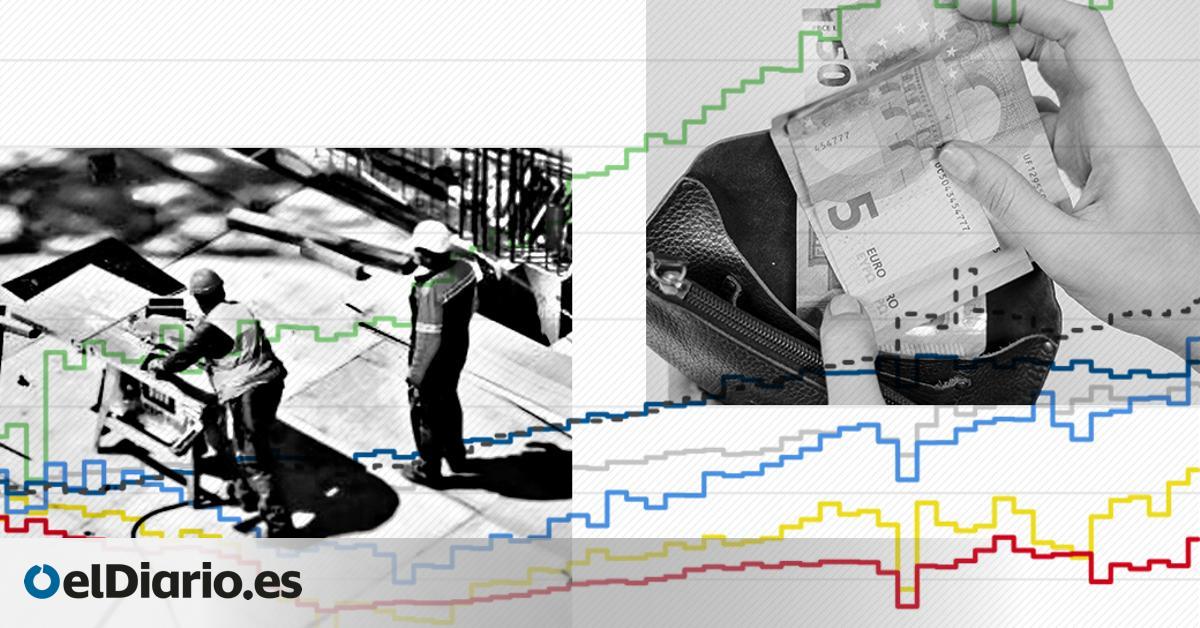
Spain has led the growth of real household income among the major economies in the last two years of inflation and interest rate crises. Household disposable income has accumulated an increase of 8.9% since the Russian invasion of Ukraine due to the creation of jobs, wage increases and the moderation of price increases.
In short: there are more people working in each family, many people earn more as self-employed workers and companies are also doing better in general. Meanwhile, inflation is giving us a break and, finally, other non-wage income is being added, such as financial income (higher returns on deposits and other products) and income from renting flats or other properties (which at the same time is making access to housing more difficult due to the distortion of tourist rentals and the shortage of supply in the main destinations and in the capitals).
According to the latest data published by the OECD on Monday, real household income in our country rose by 1.5% in the first quarter of 2024 compared to the final stretch of 2023. In that last quarter of last year, the increase was 3.74%. It was during that period that household income already exceeded the level prior to the COVID shock (just over 30,000 euros per family on average) and also the maximum level of the real estate bubble for the first time in the last 17 years.
The end of the pandemic triggered a global inflation crisis that in Europe was exacerbated by the Russian invasion of Ukraine in February 2022. The escalation in energy prices, first, and then of other products and services, inflicted historic damage on families’ ‘pockets’, especially in the central months of 2022. In addition, the European Central Bank (ECB) added the blow of increases in official interest rates throughout the eurozone.
In the fourth quarter of that year, household income stopped falling and began to recover ground. Little by little. Since then, real income per household has continued to increase in Spain. In fact, growth in our country is three times greater than in the OECD as a whole if we take as a reference the quarter in which the war in Ukraine began, as can be seen in the first graph of this report.
Spain’s economy has definitely emerged better from the pandemic and the inflation crisis than its main eurozone partners, with policies to protect the income of families and businesses. Policies that are very different from those of the 2008 financial crisis and that have focused on avoiding the destruction of jobs (with public financing of ERTEs as the best example), on improving the quality of employment by reducing temporary employment and raising wages (especially the lowest ones with the increase in the minimum wage) and on controlling the rise in energy prices.
The second graph in this report compares the evolution of real household income in the main Eurozone countries and in other EU economies such as Portugal and Poland, placing the point at which the increase or fall begins to be measured in the first quarter of 2007 (base 100). Spain’s greatest growth since 2019 does not close the growth gap that opened in the years of “internal devaluation” after the bursting of the real estate bubble and the great financial crisis of 2008. That is, after the years of austerity and cuts in social and economic rights.
The social shield
“We have deployed a social shield of more than 120,000 million [desde 2020]with measures that remain in force,” argued the First Vice President and Minister of Finance, María Jesús Montero, just before the coalition government’s summer break. This time, the various packages of measures managed to moderate price increases earlier in our country than in most European economies.
According to Eurostat data at the end of July, the cumulative inflation in Spain since 2019 is 17.8%, while in the eurozone as a whole it is 20%. Since February 2022, inflation is 11.1% and 13.2%, respectively, with almost the same positive differential for our country of two percentage points.
Another crucial driver of real household income growth is the record pace of job creation, which has reached over 21 million people in employment, a record high in Spain. The consequence of this figure is that there are more people working in families, and more families with people working. In fact, taking advantage of the end of the political year, the Minister of Economy, Trade and Business, Carlos Cuerpo, highlighted a fact: “The minimum number of households with all of their members unemployed is now below 900,000”, according to the latest Active Population Survey (EPA).
Salary increases
The other key factor in the increase in real household income is wage increases. Taking as a reference the monthly statistics of collective agreements from the Ministry of Labor, wage increases took time to take hold. The bite of inflation in 2022 (8.4% on average) on workers’ remuneration was suffocating. That year, wages rose by 3.2% on average.
In 2023, wages accelerated slightly and inflation moderated sharply, so workers regained purchasing power, as can be seen in the third chart of this report.
In 2024, wages will again lose purchasing power on average. Mainly because price increases have stagnated compared to last year, according to the CPI calculated by the INE, and because the increases in workers’ remuneration agreed in collective agreements have fallen back to 3%, again on average.
The same statistics from the Ministry of Labour show that a third of the workers who have enjoyed salary increases in their agreements so far this year have done so by more than 4%, which does imply a gain in purchasing power. That is a little over 3,200,000 people in total. This statistic is only a reference, as it does not include the agreements outside the agreement that occur in many companies, especially in the smaller ones. However, this is the most up-to-date data, which allows salaries to be compared with the CPI.
Source: www.eldiario.es

